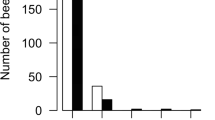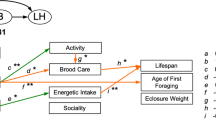Abstract
The existence of personalities has been explored in various invertebrates, but a comprehensive investigation of personality differences across individuals in a eusocial insect has not yet been conducted. The study of personality differences across individuals within the same behavioral caste may contribute to an understanding of how social insects divide labor within the nest. Here, we define and investigate three dimensions of personality within the worker caste of a model social insect, the honey bee Apis mellifera, as follows: (1) consistent individual behavioral differences over time, (2) consistent individual behavioral differences across contexts, and (3) the presence of correlated suites of behaviors. To test whether honey bee workers exhibit dimensions 1 and 2, we repeatedly assessed responses of groups of same-age bees in cages to stimuli that are relevant to bee life history. To test for dimension 3, we examined behavior within a colony context by using observation hives to record the behaviors of individual bees across their lifetimes. Our results provide some evidence for all three dimensions of personality in honey bee workers. In particular, our data suggest some individuals may be more likely to be highly interactive with other workers (e.g., engaging in food sharing), while other individuals are consistently less interactive. These findings expand upon and contribute to previous models for the organization of worker division of labor in honey bees, suggesting that consistent behavioral differences (personalities) of workers within a behavioral caste have the potential to contribute to subcaste division of labor.
Significance statement
Behavioral ecologists have become increasingly interested in animal personalities, individual behavioral differences that are consistent over time and in different contexts, with recent focus on understanding the occurrence of personalities across taxa and their adaptive value. The existence and function of personality differences among individuals in complex societies, such as eusocial insects, remain understudied. Here, we provide the first comprehensive investigation of whether workers of the highly eusocial honey bee show hallmarks of personality. Although these workers demonstrate well-documented behavioral changes as they age, we uncovered some aspects of their behavior, in particular, their tendency to physically interact with other bees, remain somewhat consistent even as they age and change roles within the colony. We suggest that individual-level personality differences have the potential to contribute to colony division of labor by creating variation in individual tendencies to perform different tasks.




Similar content being viewed by others
References
Bell AM, Hankison SJ, Laskowski KL (2009) The repeatability of behaviour: a meta-analysis. Anim Behav 77(4):771–783
Benjamini Y, Hochberg Y (1995) Controlling the false discovery rate: a practical and powerful approach to multiple testing. J Roy Stat Soc B 289-300
Beshers SN, Fewell JH (2001) Models of division of labor in social insects. Annu Rev Entomol 46(1):413–440
Briffa M, Rundle SD, Fryer A (2008) Comparing the strength of behavioural plasticity and consistency across situations: animal personalities in the hermit crab Pagurus bernhardus. P Roy Soc B-Biol Sci 275(1640):1305–1311
Butler CG, Free JB (1952) The behaviour of worker honeybees at the hive entrance. Behaviour 4(1):262–291
Calderone NW, Page RE Jr (1988) Genotypic variability in age polyethism and task specialization in the honey bee, Apis mellifera (Hymenoptera: Apidae). Behav Ecol Sociobiol 22(1):17–25
Camazine S, Crailsheim K, Hrassnigg N, Robinson GE, Leonhard B, Kropiunigg H (1998) Protein trophallaxis and the regulation of pollen foraging by honey bees (Apis mellifera L.). Apidologie 29(1-2):113–126
Chapman BB, Thain H, Coughlin J, Hughes WO (2011) Behavioural syndromes at multiple scales in Myrmica ants. Anim Behav 82(2):391–397
Charbonneau D, Dornhaus A (2015) Workers ‘specialized’ on inactivity: behavioral consistency of inactive workers and their role in task allocation. Behav Ecol Sociobiol 69(9):1459–1472
Crailsheim K (1998) Trophallactic interactions in the adult honeybee (Apis mellifera L.). Apidologie 29:97–112
Dall SRX, Houston AI, McNamara JM (2004) The behavioural ecology of personality: consistent individual differences from an adaptive perspective. Ecol Lett 7:734–739
Dall SR, Bell AM, Bolnick DI, Ratnieks FL (2012) An evolutionary ecology of individual differences. Ecol Lett 15(10):1189–1198
Duong N, Schneider SS (2008) Intra-patriline variability in the performance of the vibration signal and waggle dance in the honey bee, Apis mellifera. Ethology 114(7):646–655
Durr R, Smith C (1997) Individual differences and their relation to social structure in domestic cats. J Comp Psychol 111(4):412
Erber J, Hoormann J, Scheiner R (2006) Phototactic behaviour correlates with gustatory responsiveness in honey bees (Apis mellifera L.). Behav Brain Res 174(1):174–180
Farina WM (1996) Food-exchange by foragers in the hive—a means of communication among honey bees? Behav Ecol Sociobiol 38(1):59–64
Farina WM, Núñez JA (1991) Trophallaxis in the honeybee, Apis mellifera (L.) as related to the profitability of food sources. Anim Behav 42(3):389–394
Gosling SD (2001) From mice to men: what can we learn about personality from animal research? Psychol Bull 127(1):45
Grüter C, Acosta LE, Farina WM (2006) Propagation of olfactory information within the honeybee hive. Behav Ecol Sociobiol 60(5):707–715
Herborn KA, Macleod R, Miles WT, Schofield AN, Alexander L, Arnold KE (2010) Personality in captivity reflects personality in the wild. Anim Behav 79(4):835–843
Hölldobler B, Wilson EO (1990) The ants. Harvard University Press, Cambridge
Jandt JM, Bengston S, Pinter-Wollman N, Pruitt JN, Raine NE, Dornhaus A, Sih A (2014) Behavioural syndromes and social insects: personality at multiple levels. Biol Rev 89(1):48–67
Johnson BR (2008) Within-nest temporal polyethism in the honey bee. Behav Ecol Sociobiol 62(5):777–784
Kirchner WH, Gadagkar R (1994) Discrimination of nestmate workers and drones in honeybees. Insect Soc 41(3):335–338
Kralj-Fišer S, Schuett W (2014) Studying personality variation in invertebrates: why bother? Anim Behav 91:41–52
LeBoeuf AC, Grozinger CM (2014) Me and we: the interplay between individual and group behavioral variation in social collectives. Current Opinion in Insect Science 5:16–24
Leoncini I, Le Conte Y, Costagliola G, Plettner E, Toth AL, Wang M, Huang Z, Bécard J-M, Crauser D, Slessor KN, Robinson GE (2004) Regulation of behavioral maturation by a primer pheromone produced by adult worker honey bees. PNAS 101(50):17559-17564
Liang ZS, Nguyen T, Mattila HR, Rodriguez-Zas SL, Seeley TD, Robinson GE (2012) Molecular determinants of scouting behavior in honey bees. Science 335(6073):1225–1228
Mather JA, Logue DM (2013) The bold and the spineless: invertebrate personalities. In: Carere C, Maestripieri D (eds) Animal personalities: behavior, physiology, and evolution. The University of Chicago Press, Chicago, pp 13–35
Moore D, Angel JE, Cheeseman IM, Robinson GE, Fahrbach SE (1995) A highly specialized social grooming honey bee (Hymenoptera: Apidae). J Insect Behav 8(6):855–861
Oksanen J, Blanchet FG, Kindt R, Legendre P, Minchin PR, O’Hara RB et al (2013) Package ‘vegan’. R Package ver 254, 20-8
Oster GF, Wilson EO (1978) Caste and ecology in the social insects. Princeton University Press, Princeton
Page RE Jr (2013) The spirit of the hive. Harvard University Press, Campbridge
Page RE Jr, Erber J (2002) Levels of behavioral organization and the evolution of division of labor. Naturwissenschaften 89(3):91–106
Page RE Jr, Mitchell SD (1990) Self organization and adaptation in insect societies. In PSA: Proceedings of the biennial meeting of the philosophy of science association. Philosophy of Science Association, pp 289–298
Page RE Jr, Erber J, Fondrk MK (1998) The effect of genotype on response thresholds to sucrose and foraging behavior of honey bees (Apis mellifera L.). J Comp Physiol A 182(4):489–500
Pankiw T, Page RE Jr (1999) The effect of genotype, age, sex, and caste on response thresholds to sucrose and foraging behavior of honey bees (Apis mellifera L.). J Comp Physiol A 185(2):207–213
Pankiw T, Winston ML, Slessor KN (1994) Variation in worker response to honey bee (Apis mellifera L.) queen mandibular pheromone (Hymenoptera: Apidae). J Insect Behav 7(1):1–15
Pankiw T, Waddington KD, Page RE Jr (2001) Modulation of sucrose response thresholds in honey bees (Apis mellifera L.): influence of genotype, feeding, and foraging experience. J Comp Physiol A 187(4):293–301
Pinter-Wollman N, Hubler J, Holley JA, Franks NR, Dornhaus A (2012) How is activity distributed among and within tasks in Temnothorax ants? Behav Ecol Sociobiol 66(10):1407–1420
Powledge TM (2011) Behavioral epigenetics: how nurture shapes nature. Bioscience 61(8):588–592
Pruitt JN, Grinsted L, Settepani V (2013) Linking levels of personality: personalities of the ‘average’ and ‘most extreme’ group members predict colony-level personality. Anim Behav 86(2):391–399
Rasmussen EM, Amdam, GV (2015) Cytosine modifications in the honey bee (Apis mellifera) worker genome. Frontiers in genetics 6
Réale D, Reader SM, Sol D, McDougall PT, Dingemanse NJ (2007) Integrating animal temperament within ecology and evolution. Biol Rev 82(2):291–318
Revelle W (2014) psych: procedures for personality and psychological research, Northwestern University, Evanston, Illinois, USA, http://CRAN.R-project.org/package=psych Version = 1.4.8
Rittschof CC, Coombs CB, Frazier M, Grozinger CM, Robinson GE (2015). Early-life experience affects honey bee aggression and resilience to immune challenge. Sci Rep 5
Robinson GE (1992) Regulation of division of labor in insect societies. Annu Rev Entomol 37(1):637–665
Robinson GE, Page RE Jr (1988) Genetic determination of guarding and undertaking in honey-bee colonies. Nature 333(6171):356–358
Robinson GE, Page RE Jr (1989) Genetic determination of nectar foraging, pollen foraging, and nest-site scouting in honey bee colonies. Behav Ecol Sociobiol 24(5):317–323
Robinson GE, Underwood BA, Henderson CE (1984) A highly specialized water-collecting honey bee. Apidologie 15(3):355–358
Sakagami SF (1954) Occurrence of an aggressive behaviour in queenless hives, with considerations on the social organization of honeybee. Insect Soc 1(4):331–343
Scheiner R (2012) Birth weight and sucrose responsiveness predict cognitive skills of honeybee foragers. Anim Behav 84(2):305–308
Seeley TD (1982) Adaptive significance of the age polyethism schedule in honeybee colonies. Behav Ecol Sociobiol 11(4):287–293
Seeley T (1985) Honeybee ecology: a study of adaptation in social life. Princeton University Press, Princeton
Seeley TD, Morse RA (1976) The nest of the honey bee (Apis mellifera L.). Insect Soc 23(4):495–512
Sih A, Bell A, Johnson JC (2004) Behavioral syndromes: an ecological and evolutionary overview. Trends Ecol Evol 19(7):372–378
Simone-Finstrom M, Gardner J, Spivak M (2010) Tactile learning in resin foraging honeybees. Behav Ecol Sociobiol 64(10):1609–1617
Tenczar P, Lutz CC, Rao VD, Goldenfeld N, Robinson GE (2014) Automated monitoring reveals extreme interindividual variation and plasticity in honeybee foraging activity levels. Anim Behav 95:41–48
Williams GR, Alaux C, Costa C, Csáki T, Doublet V, Eisenhardt D, Fries I, Kuhn R, McMahon DP, Medrzycki P, Murray TE (2013) Standard methods for maintaining adult Apis mellifera in cages under in vitro laboratory conditions. J Apic Res 52(1):1-36
Wilson EO (1971) The insect societies. Harvard University Press, Cambridge
Winston ML (1987) The biology of the honey bee. Harvard University Press, Cambridge
Wray MK, Seeley TD (2011) Consistent personality differences in house-hunting behavior but not decision speed in swarms of honey bees (Apis mellifera). Behav Ecol Sociobiol 65(11):2061–2070
Wray MK, Mattila HR, Seeley TD (2011) Collective personalities in honeybee colonies are linked to colony fitness. Anim Behav 81(3):559–568
Acknowledgments
We would like to thank the members of the Toth lab for the helpful suggestions on these experiments and feedback on the manuscript. We would like to thank Kate Hunter for the assistance with behavioral observations and Eric Gangloff for the guidance on statistical analyses.
Conflict of interest
The authors declare that they have no conflict of interest.
Author information
Authors and Affiliations
Corresponding author
Additional information
Communicated by O. Rueppell
This manuscript is a contribution to the special issue Integrative Analysis of Division of Labor—Guest Editors: Simon K. Robson, James F. A. Traniello.
Electronic supplementary material
Below is the link to the electronic supplementary material.
ESM 1
Supplemental Figure 1. Box-and-whisker plots of age polyethism of bees in observation hives. The pattern of behavioral transition observed in this study reflected patterns observed in previous studies (Seeley 1982; Winston 1987). Red represents interactive tasks and blue represents non-interactive tasks. (DOC 82 kb)
ESM 2
Supplemental Table 1. Spearman rank correlations of same behaviors performed within a context and different behaviors performed in different contexts. P-values are shown after a Benjamini-Hochberg correction. (DOC 36.5 kb)
Rights and permissions
About this article
Cite this article
Walton, A., Toth, A.L. Variation in individual worker honey bee behavior shows hallmarks of personality. Behav Ecol Sociobiol 70, 999–1010 (2016). https://doi.org/10.1007/s00265-016-2084-4
Received:
Revised:
Accepted:
Published:
Issue Date:
DOI: https://doi.org/10.1007/s00265-016-2084-4




